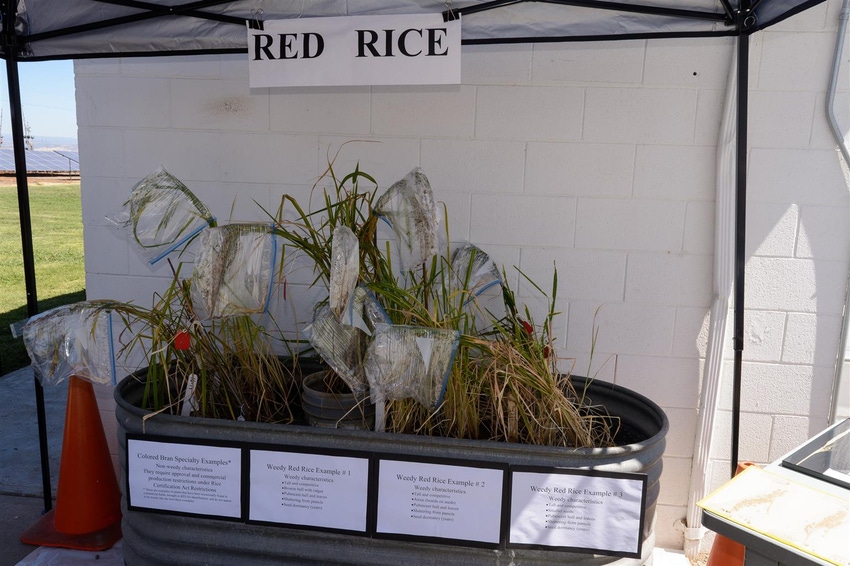June 7, 2017

California rice growers are discovering a challenge in their fields that some thought was merely herbicide-resistant watergrass.
Last year, newly-hired University of California (UC) Cooperative Extension Rice Advisor Whitney Brim-DeForest began receiving calls from rice growers about a weed they couldn’t kill. This led to the quick discovery that watergrass wasn’t the problem.
Since the beginning of the 2016 growing season, at least 10,000 acres of rice ground in California has been identified with weedy rice, one of the most damaging weeds of rice worldwide.
As growers began reporting the problem to farm advisors and the California Rice Commission (CRC), UC teamed with the CRC to help growers understand what weedy rice is and what it's not. Knowing what it’s not can reassure growers concerned with regulatory constraints.
Since it is not considered something requiring state or federal quarantines, growers can be rest assured that “there are no repercussions because it’s just rice,” she said.
The issue is simply one of what markets will tolerate in terms of contamination in the milled product.
Shortly after assuming her post in 2016 Brim-DeForest was made aware of the widespread nature of weedy rice in California fields. What was first thought to be just a “spotty” problem found in a handful of fields in the northern Sacramento Valley quickly became identified across 10,000 acres of rice statewide.
Brim-DeForest searched through journals and other publications on the topic. She quickly discovered that weedy rice, or red rice (known for this by its color), is of the same genus and species as cultivated rice, albeit an unwelcome one. Because of this, it does not present a human health risk if it is mixed with the cultivated rice chain.
The challenge is it cannot be controlled by approved herbicides.
According to UC, it can significantly affect yield and quality. Yields in the Mid-South have been reduced by 60 percent where this is present.
Brim-DeForest’s study of weedy rice reveals that it was rediscovered in California in 2006. Historic records show it was present before 1950, but little was said about it since then.
A 2008 survey of rice in the Sacramento Valley turned up three fields with it. Then the Rice Research Board and CRC set up a task force to look into the issue, but it quickly “fell off the radar” of those in the rice industry, she said.
Though some pest control advisers were starting to see something and were bringing samples into the Rice Experiment Station in Richvale, Calif., Brim-DeForest says there was no official mechanism to track weedy rice until years later when it was beginning to show up as a more widespread problem.
Rice mills surveyed by UC said they’d seen it “for years,” she said, but reported some confusion in identifying it because there are red-colored rice bran varieties that the industry purposefully grows for certain markets.
“A lot of folks thought it was just contamination from colored rice,” Brim-DeForest said.
Identification and treatment
In cooperation with UC, the CRC produced a website at http://caweedyrice.com/ to help growers and PCAs identify the problem and understand what to do if growers think it might be in their fields. Growers can subscribe on the website for e-mail updates.
UC has now established a set of best management practices for weedy rice, which propagates itself by shattering easily and leaving seed on the soil. According to Brim-DeForest, this seed can lay dormant for many years before germinating.
Weedy rice is easiest to identify at the heading stage, though it is possible to identify before that. UC rice advisors can help in this identification. The weedy rice website can also be helpful.
Because weedy rice shatters easily, Brim-DeForest does not recommend growers or PCAs pull samples themselves and transport them for identification. Contact the farm advisor’s office to get instructions on how to have it identified.
Though it’s not easy, weedy rice can be controlled, according to Luis Espino, UC rice farming systems advisor for Colusa, Glenn and Yolo counties.
Espino is working with growers to do just that. One grower he continues to work with fallowed a 15-acre check in his field for two seasons while employing practices recommended by university researchers.
In this case, the grower fallowed the check, did minimal ground work including running a disc and roller on the field before flushing the field with irrigation water to germinate weeds, including the weedy rice.
With the weeds germinated, the grower applied glyphosate to the fallowed field in two separate applications. Though glyphosate is not a registered product for use in rice, Espino says its use on fallowed rice ground is permitted.
Glyphosate was applied over two seasons to the fallowed field, killing many of the weeds present.
After two seasons, the grower replanted the field in rice. When the rice began to head, he hand-rogued the remaining weedy rice in the field. This appears to have had a positive impact on the grower’s weed pressure, Espino says.
Burning rice fields after harvest has not proven successful, though Brim-DeForest thinks a sufficiently hot fire could have an impact. Because of current air district rules and the spotty effects of rice stubble burning with respect to weedy rice seed, Espino says UC does not recommend burning as a control or treatment method.
The UC will host meetings later in the growing season to update growers on weedy rice.
Growers in Placer, Sacramento, Sutter, Yuba and Butte counties who suspect weedy rice in fields can contact Brim-DeForest at (530) 822-7515. Growers in Colusa, Glenn and Yolo counties should contact Espino at (530) 458-0570. Those in San Joaquin County can call Michelle Leinfelder-Miles at (209) 953-6120.
You May Also Like




